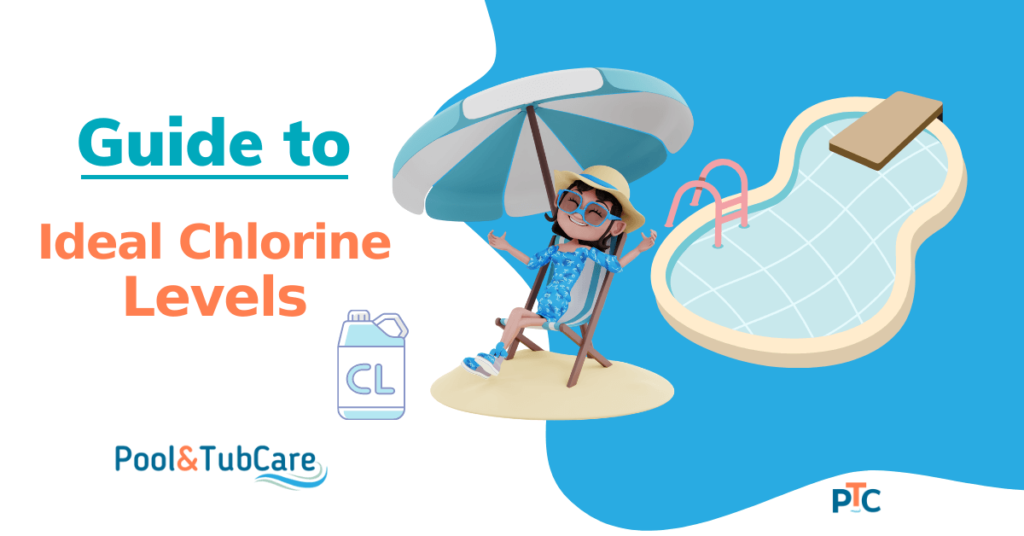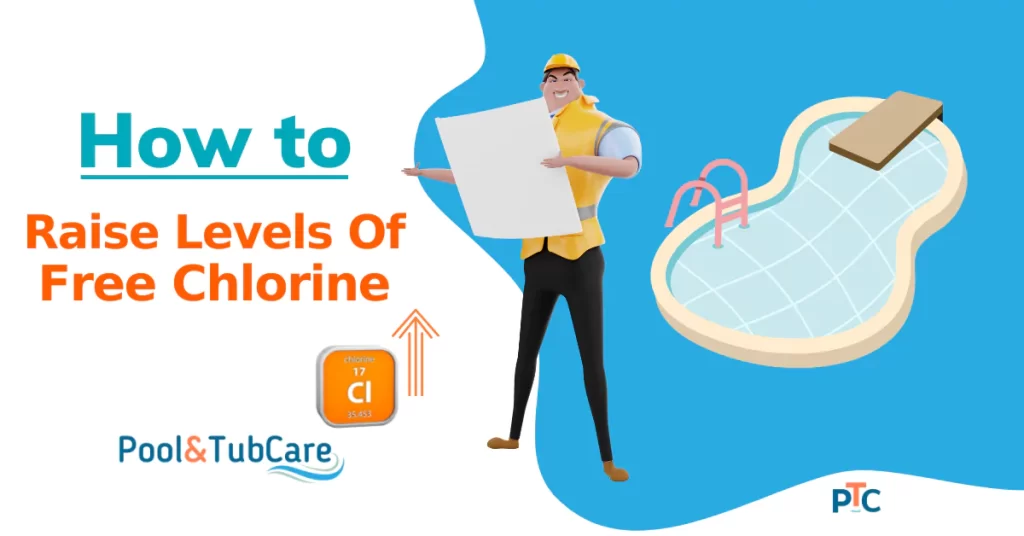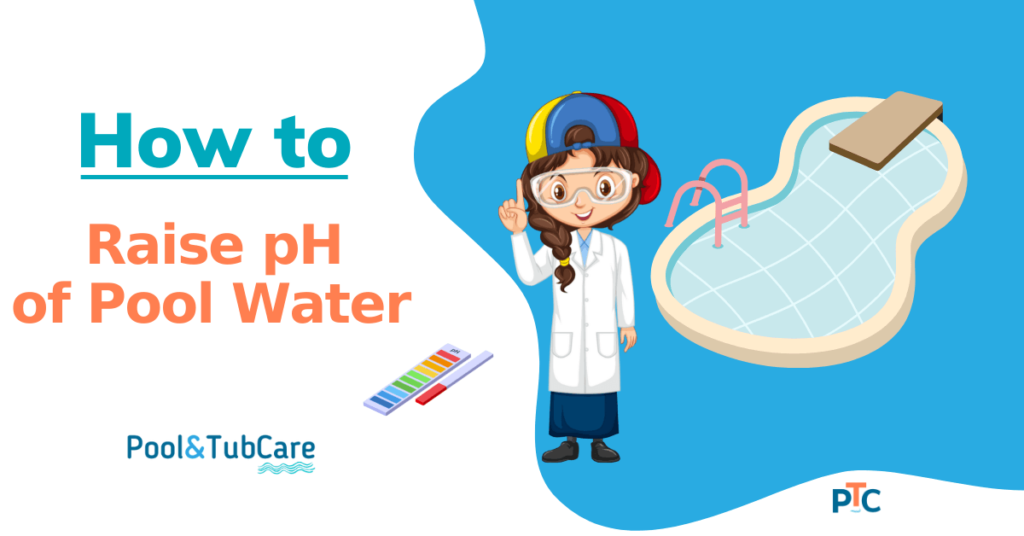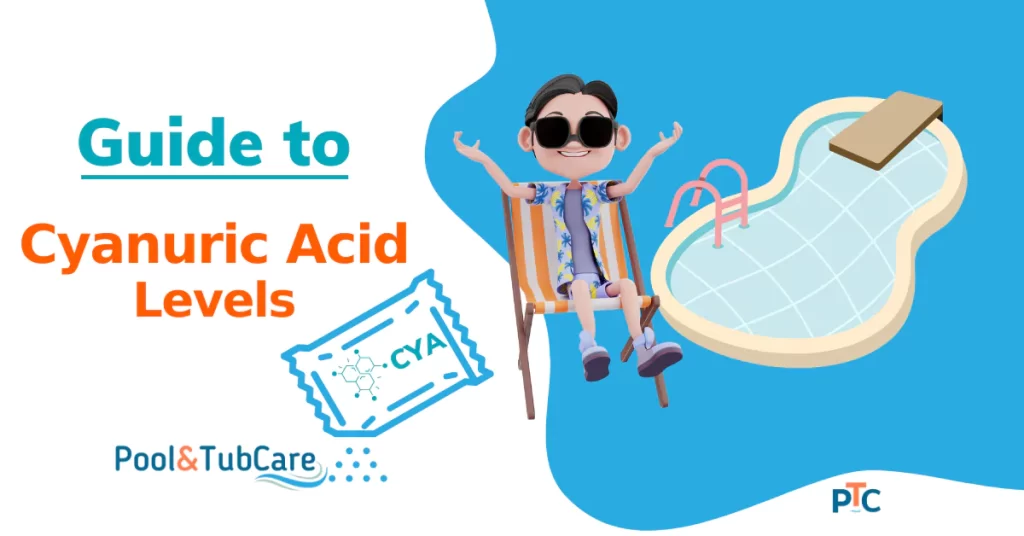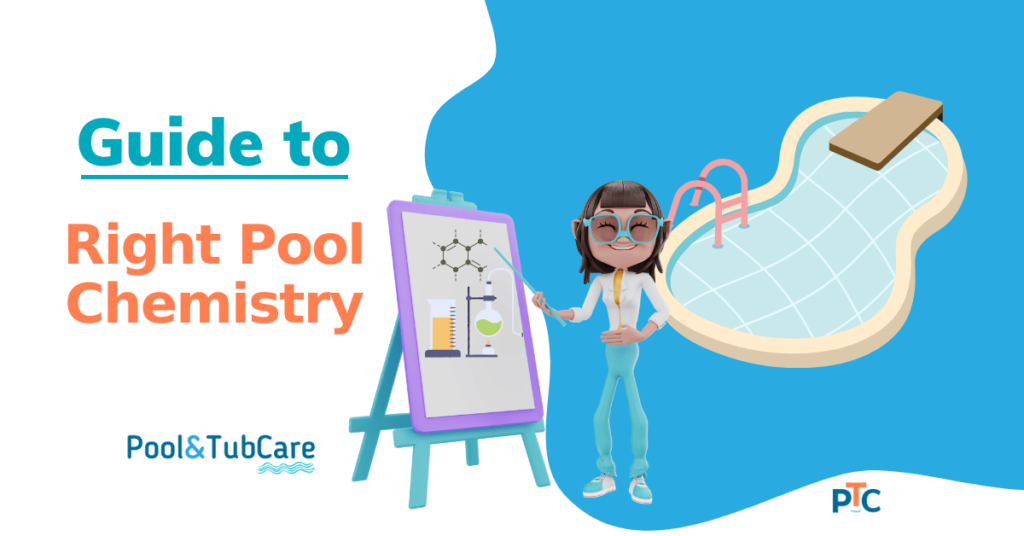Chlorine is one of the most commonly used disinfectants in swimming pools and spa tubs. Its primary function is to kill bacteria and other pathogens that might cause diseases. Too much chlorine levels, on the other hand, might be dangerous to your health.
For swimming pools and spa tubs, the U.S. Environmental Protection Agency (EPA) recommends a maximum chlorine level of 4 parts per million (ppm). The Centres for Disease Control and Prevention (CDC) recommends a maximum chlorine level of 3 ppm for pools and spas and a minimum of 1 ppm.
If you wish to swim in a clean pool, regularly check the chlorine levels of your pool. Read on to know more details on how to maintain ideal chlorine levels in your pool.
What is Chlorine and How Does it Work in Pool Water
Adding chlorine to the pool water is called chlorination. Chlorine is regularly used in keeping swimming pools clean and safe for swimmers.
Chlorine works as a sanitizer and helps combat any impurities in the water.
When chlorine is added to pool water, it forms hypochlorous acid, a weak acid, and this acid kills bacteria and other pathogens in water.
Chlorine also reacts with organic waste and get is removed via filters.
Pool water usually has 1-3 ppm (parts per million) of chlorine. Chlorine must be regularly circulated through the pool water through a filtration system for it to be effective throughout the water.
The filtration system filters out debris from the water, and the chlorine kills any bacteria that are present.
Test pool water regularly to ensure that the chlorine level is within the appropriate range.
Swimmers can be harmed by too much chlorine, while too little allows bacteria to proliferate.
What Chlorine Levels are Safe to Swim in Pools
The ideal amount of free chlorine in water should be between 1-3 ppm.
Check the chlorine levels daily or alternate days to keep a tab. Levels of free chlorine should never get below 1ppm. Below 1ppm of chlorine, many bacteria can grow in pool water.
Because of higher usage, most commercial pools have chlorine levels between 3-5 ppm.
Swimming is safe in the water with chlorine levels up to 5 ppm, but anything over that can be dangerous.
Related: Ideal water chemistry for your pool!
How to Check Chlorine Levels in Your Pool
There are several ways to check the chlorine levels in your pool, and a test strip is the most common method.
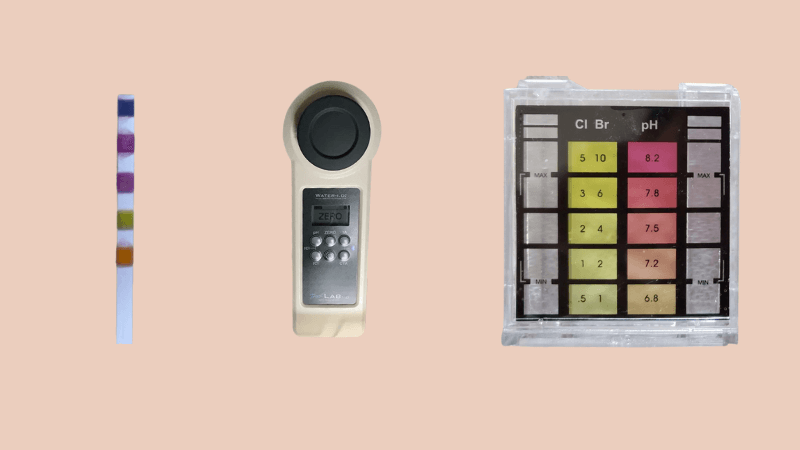
To use a test strip, dip a test strip in water for a few seconds before comparing the developed color of the test strip to the chart that came with it.
A chlorine test kit can also be purchased at a pool supply store, and these kits typically include a liquid chemical and a color chart.
Follow the steps on how to use the kit that come with the kit.
An electronic tester can also be used to monitor chlorine levels. These testers cost more than test strips or test kits but are more accurate.
Why Maintaining Chlorine Levels is Important
Keeping the chlorine levels balanced is one of the essential aspects of pool maintenance.
Chlorine is necessary to keep the water clean and clear and prevent bacteria and algae growth.
Too much or too little chlorine, on the other hand, may be harmful to swimmers and pool equipment.
Chlorine gets broken by sunlight very fast unless protected by Cyanuric Acid, so you should check chlorine daily or on alternate days and adjust accordingly.
Different Types of Chlorine
In your pool, chlorine is present in two different forms: free chlorine and combined chlorine.
The most common type is free chlorine, a form of chlorine that is not bonded to any other molecules.
This is the free chlorine that works as a sanitizer to clean your pool, and the level of free chlorine should never be less than 1ppm.
In contrast, combined chlorine is chlorine that has bonded to other molecules in water, rendering it ineffective as a sanitizer.
When you add both free chlorine and combined chlorine, you get total chlorine.
To have a properly sanitized pool, it is essential to test the water for both free and combined chlorine levels regularly. Most inexpensive kits measure total chlorine and free chlorine, and you can get the value of combined chlorine by subtracting free chlorine from total chlorine.
An ideal clean pool will have zero combined chlorine as it has no impurities. The amount of combined chlorine increase as free chlorine neutralizes more contaminants. Ideally, combined chlorine should not be more than 0.2 ppm and if it goes above, then shocking your pool is recommended.
Combined chlorine can be eliminated from pool water by shocking, which involves adding a large amount of chlorine all at once.
Shocking should be done frequently to keep the pool safe and clean.
What Happens If Pool has Too Much Chlorine
There are a few things that can happen if your pool has too much chlorine in it.
- The water could irritate your skin and eyes
- If chlorine levels remain high for longer, the pool surfaces may get stained or discolored
- High chlorine can bleach the swimwear and also cause green hair in a few cases
- If the chlorine levels go too high, it can produce toxic fumes that are hazardous to breathe
If there are signs that the pool has too much chlorine, test the water and adjust the levels accordingly.
What Happens If You Swim in a Pool with Too Much Chlorine
If you swim in a pool with very high chlorine levels, your skin and eyes may become irritated.
The chlorine can also cause your skin and hair to become dry and brittle. Too much chlorine can induce nausea and vomiting in some people.
In a few cases, skin redness and rashes may occur.
Too much chlorine also generates a hazardous gas that can cause Asthma or irritation in the respiratory tract.
Get out of the pool immediately if you feel anything like that and rinse off with fresh water.
How to Reduce Chlorine Levels in a Pool
If you have too much chlorine, there is nothing to worry about as chlorine breaks down on its own in sunlight UV rays.
If you have some time, leave your pool for a couple of days, and chlorine levels will get down to normal.
For an above-ground pool, consider draining and refilling it with new water if you need to urgently lower the chlorine levels.
This is a more drastic method, but it will effectively reduce your pool’s chlorine levels.
There are also a few chemicals that can break down chlorine for you quickly.
To reduce combined chlorine or chloramines in your pool, you need to shock your pool.
What Happens if Pool has Too Little Chlorine
Without sufficient free chlorine (at least 1ppm), your pool might become a breeding ground for microscopic organisms like bacteria and algae.
The water with low chlorine levels can become dirty and murky.
Due to the lack of proper sanitization, swimming in a pool with low chlorine levels can be hazardous.
Test the water regularly, and if the levels are on the lower end, add more chlorine as needed.
How to Increase Chlorine Levels in a Pool
You may do a few things to increase the chlorine levels in your pool if necessary.
As an initial step, use chlorine pills or pellets explicitly made for pools.
These products can be used to increase the chlorine levels in water by adding them to it.
Another option is to shock the pool with a high concentration of chlorine, and this will also help in killing any bacteria or algae present.
Chlorine Shock for Pools
Most pool owners know the concept of chlorine shock but might be unaware of its importance.
Chlorine shock means adding a huge amount of chlorine to the pool to get a higher concentration than normal to reach a breakpoint of chlorine (chloramines).
Typically, this is done to kill off algae or other pathogens that have entered the water.
To maintain your swimming pool clean, you should shock it regularly.
Related: How to shock your pool!
Ideal pH Level for Chlorine to Work
Other than chlorine, pH is another important factor for your pool chemistry.
The ideal pH of water is 7.4 and between 7.2 to 7.6.
Other than that, it is also critical for the working of chlorine.
If the pH is too high or too low, chlorine may not work effectively, leaving your pool more prone to bacteria and algae growth.
The human body pH is around 7.4, therefore, it is ideal for swimmers. High or low pH levels might cause skin and eye irritation.
Test pH levels regularly and if the pH levels are off, you can use many ways to lower or raise the pH.
Automated Chlorine Feeders
Most pool owners know that chlorine is essential for keeping the water clean and safe. Manually adding chlorine, on the other hand, may be time-consuming and tedious.
Automated chlorine feeders are an excellent solution for busy pool owners who wish to keep their pool in good condition with minimal effort.
These devices are linked to the pool’s filtration system and continuously deliver chlorine to the water.
They are designed to release chlorine at regular intervals or only when the water’s chlorine falls below a specified threshold.
How Much Chlorine to Add to Pool
It’s essential to use a precise amount of chlorine when adding to your pool.
Of course, the amount of chlorine you’ll need to add will depend on various things, like the pool size, the weather, and how frequently you use the pool.
Remember to account for the total gallons of water in your pool when calculating how much chlorine you’ll need.
Once you have the total volume, the math is simple: One ounce of chlorine equals one part per million (ppm) in 7500 gallons of water, and this equates to 0.013 ounces of chlorine per 100 gallons of water.
You can also check out this chlorine calculator to determine the exact amount.
Because direct sunlight breaks down chlorine and causes its levels to decrease over time, it’s always a good idea to evaluate the chlorine levels regularly and adjust as needed.
Things That Disturb Chlorine Levels in Pool
Chlorine levels can be readily disrupted, potentially causing water quality problems.
The presence of ammonia in pool water is a common problem. Ammonia may be found in many places, including urine, sweat, and cosmetics.
It can produce chloramines combined with chlorine, which can cause skin and eye redness.
Furthermore, organic matter like leaves and soil might impact chlorine levels.
When these materials decompose in the water, they release chemicals that can neutralize chlorine.
Related: How to remove leaves from the pool!
Signs That Chlorine Levels are Off
Check for a few signs if you sense your pool’s chlorine levels are off.
For example, if the water seems cloudy or has an unusual odor, this could indicate that the chlorine levels are too low.
If you detect a strong chlorine odor, it is not an indication of high chlorine (free) levels but rather that chlorine levels are low and are being transformed into chloramines, which cause the odor.
On the other hand, if your eyes or skin get red and itchy after swimming, it could indicate that the chlorine levels are too high.
Of course, the only way to be sure is to use a pool test kit to check the chlorine levels.
Chlorine Using Tips
While using chlorine in your pool, you should remember a few things to get the best results.
First and foremost, use high-quality chlorine. Cheaper brands may be ineffective and cost you more in the long run.
When working with chlorine, use old clothes, as it could quickly destroy clothes by causing bleach stains. Keeping chlorine pills in a safe place where children and animals cannot get them is essential.
Do not put chlorine pills in your skimmer basket because it can result in areas of concentrated high chlorine levels, which can damage equipment and cause difficult-to-remove stains.
Always use protective clothing like gloves, long pants, and long-sleeved shirts to avoid coming into close touch with chlorine or breathing it.
Now You Know Ideal Chlorine Levels for Your Pool
A constant supply of chlorine at an optimal concentration in your pool is essential for keeping it clean and preventing water-borne diseases.
To keep your swimming pools’ chlorine level consistent between 1-3 ppm, test the water chlorine regularly. Maintaining chlorine levels is less expensive than dealing with the consequences of low chlorine.
Following the suggestions above, you can ensure that your pool has the right amount of chlorine and stays clean throughout the season!
FAQs
Here are a few frequently asked questions.
What chlorine level is too high to swim in?
The recommended chlorine level in swimming pools is between 1 and 3 ppm, and anything beyond five is considered very high and can be dangerous to swimmers.
How do you tell if there is too much chlorine in a pool?
High levels of chlorine in a pool can cause skin rashes, red eyes, and coughing. Ultimately, you need to test the levels with a kit to determine the exact values.
Can too much chlorine in the pool make you sick?
Yes, swimmers can fall sick if the chlorine level in a pool is too high.
Vomiting, nausea, and difficulty breathing are all symptoms of chlorine poisoning. Seek medical assistance immediately if you suffer any of these symptoms after swimming in a pool.
How long does it take for chlorine to evaporate from a pool?
Chlorine levels can quickly drop, particularly in hot weather. Evaporation may remove 90% of free chlorine in two to three hours. As a result, it is essential to use a stabilizer like cyanuric acid.

